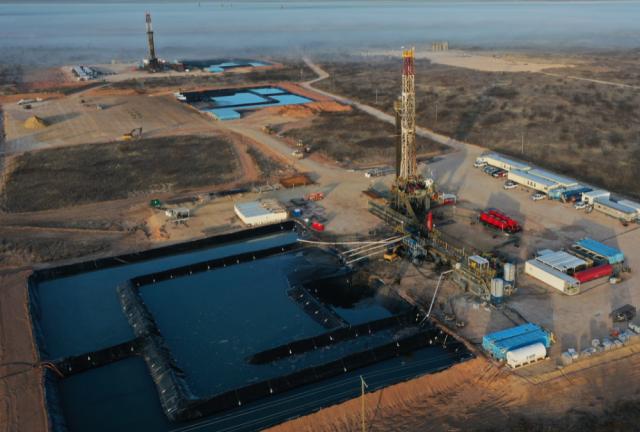
Rigs are show in West Texas. (Source: Mike Irvin/Shutterstock.com)
Though global oil demand is forecast to rise alongside a potentially looming oil supply deficit, analysts don’t expect U.S. shale producers—at least not the public ones—to help fill the gap by producing much more this summer if disaccord persists during OPEC+ negotiations.
That could, however, change next year as U.S. production rises.
For now, public producers have little incentive to significantly pump more, given most of their 2021 crude output is hedged way below today’s oil prices of more than $74/bbl, Rystad Energy analysts said. Plus, many are sticking to promises to exercise capital discipline and boost shareholder payouts.
Temptation to ramp up production may also be low for some producers who don’t hedge, despite improved oil prices compared to a year ago, if “higher prices are perceived as a structural change rather than short-term rebalancing,” according to Rystad.
The firm projects oil demand will rise 1.5 MMbbl/d between July and August.
“Even if the U.S. shale industry wanted to produce more, the time required from a price signal to a significant production impact is at least nine months, including the time it takes to make an investment decision, the months needed from spud to frac end, plus the last stage from frac end to peak production,” Artem Abramov, head of shale research at Rystad Energy, said in a news release July 9.
The analysis was delivered after a so-called “impasse” added to uncertainty during the latest OPEC and OPEC+ meeting.
RELATED
Oil Prices Firm on US Inventories Decline Despite OPEC+ Impasse
Despite Oil High Price, US Shale Firms Hesitate to Pump, Hedge More
BP: Oil Accounted for Most of 2020’s Cut in Energy Demand
As the world recovers from the pandemic and demand picks up this summer, Rystad said this increases the amount of oil needed from OPEC+ producers to reach equilibrium, neither drawing nor building inventories.
“If the impasse takes a turn for the worse, the market has some breathing space to absorb extra barrels—up to 1.6 MMbbl/d in August to be in perfect balance, a threshold that–if not filled by OPEC+ or other barrels,” Louise Dickson, oil markets analyst for Rystad, said in a separate statement. “Nevertheless, with oil demand projected to increase 1.5 million bpd between July and August 2021, something has to give on the supply side to keep up.”
In the U.S., crude and gasoline stocks have fallen as gasoline demand surges.
Private and public producers continue to lower inventories of drilled by uncompleted wells. Rystad data show the DUC count was below 5,000 in June, a drop of at least 1,000 from May. The firm forecasts total U.S. crude oil output will reach 11.51 MMbb/d this month, up 60,000 bbl/d. Expectations are for flat production in August before falling to 11.41 MMbbl/d in October and gradually increasing to 11.62 MMbbl/d by year-end to steadily rise throughout 2022.
The U.S. Energy Information Administration pointed this week to rising production in the coming months. In its Short-Term Energy Outlook, released July 7, the EIA said it expects OPEC and partner nonmember countries (OPEC+) will drive production growth.
“We expect rising production will reduce the persistent global oil inventory draws that have occurred for much of the past year and keep prices similar to current levels, averaging $72/b during the second half of 2021 (2H21),” the EIA said. “However, in 2022, we expect that continuing growth in production from OPEC+ and accelerating growth in U.S. tight oil production, along with other supply growth, will outpace growth in global oil consumption and contribute to declining oil prices.”
Data from the International Energy Agency (IEA) show global oil demand rising by 5.4 MMbbl/d this year and 3.1 MMbbl/d in 2022, returning to pre-pandemic levels with 99.5 MMbbl/d.
With growth of 1.8 MMbbl/d, most of the increased demand is expected to come from non-OECD countries.
Recommended Reading
Marathon Petroleum Sets 2024 Capex at $1.25 Billion
2024-01-30 - Marathon Petroleum Corp. eyes standalone capex at $1.25 billion in 2024, down 10% compared to $1.4 billion in 2023 as it focuses on cost reduction and margin enhancement projects.
Humble Midstream II, Quantum Capital Form Partnership for Infrastructure Projects
2024-01-30 - Humble Midstream II Partners and Quantum Capital Group’s partnership will promote a focus on energy transition infrastructure.
Hess Corp. Boosts Bakken Output, Drilling Ahead of Chevron Merger
2024-01-31 - Hess Corp. increased its drilling activity and output from the Bakken play of North Dakota during the fourth quarter, the E&P reported in its latest earnings.
The OGInterview: Petrie Partners a Big Deal Among Investment Banks
2024-02-01 - In this OGInterview, Hart Energy's Chris Mathews sat down with Petrie Partners—perhaps not the biggest or flashiest investment bank around, but after over two decades, the firm has been around the block more than most.
Some Payne, But Mostly Gain for H&P in Q4 2023
2024-01-31 - Helmerich & Payne’s revenue grew internationally and in North America but declined in the Gulf of Mexico compared to the previous quarter.






